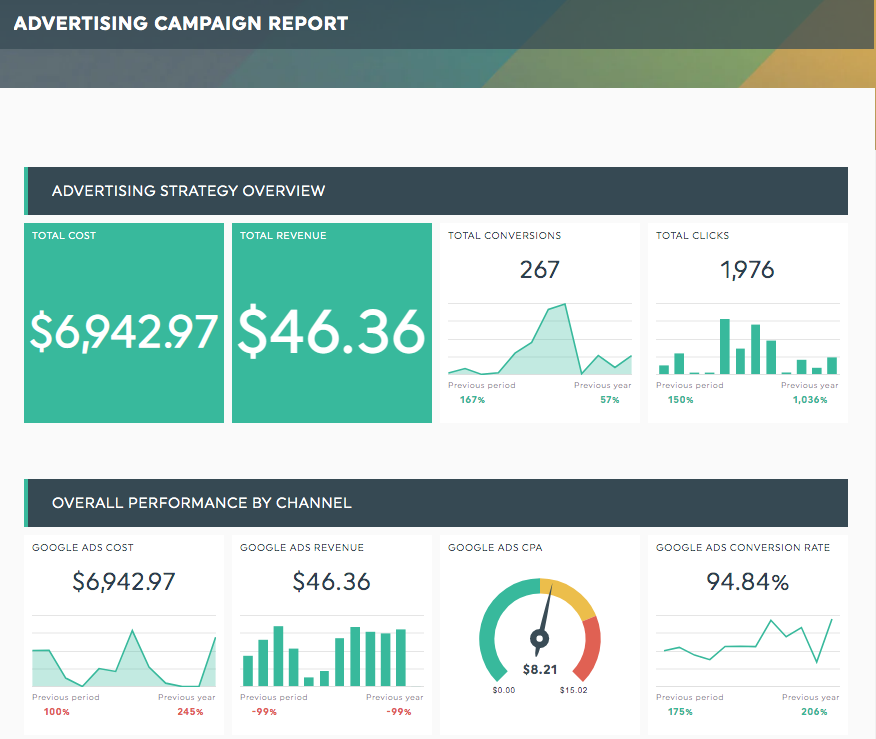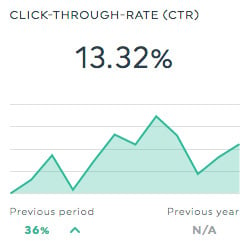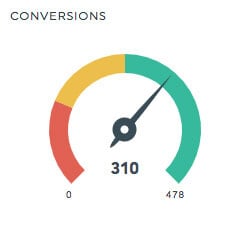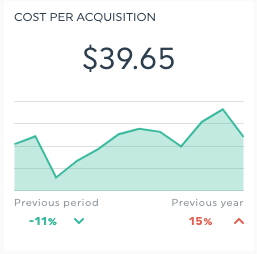The Top 5 Advertising and Paid Media KPIs to Track in Your Campaign Dashboard

With the growing number of digital media outlets that marketers have access to, it can be difficult to navigate the sea of data available - and in turn, transform important metrics into actionable insight. In a sense, it can be very overwhelming: whether it's video advertising, social media campaigns, or paid search, it's hard to know what to measure and why.
Well today is your lucky day because if paid ads are part of your marketing strategy, we are going to dive into a few of the high-level paid media metrics that you can easily track in your advertising dashboard.
Here's what you'll learn in this article :
- What are advertising and paid media KPIs?
- Top paid media KPI to track in your campaign dashboard
- - Impressions & Reach
- - Clicks
- - Click-through rate
- - Conversions & Conversion rate
- - Customer acquisition cost
- Finding the right marketing metrics to analyze
- Paid media overview
What are advertising and paid media KPIs?
Advertising and paid media key performance indicators (KPIs) measure how your paid or ad campaign is performing.
In other words, these metrics track if you’re meeting—or exceeding—your goals so that you can plan your next moves. For example, in social media marketing, the way to monitor your campaigns could be by checking the engagement metrics on your Facebook ad. And with Dashthis, you can create a dashboard specifically for your social media metrics or your SEO results.
Top advertising and paid KPIs to track
Although most of the major search and social media advertising platforms have their own unique media metrics, let's focus on the ones that always stay tried and true across all marketing channels.
In DashThis, you will find plenty of pre-set widgets available to easily display these paid media metrics across many integrations. You will just need to connect your google analytics or your social media platforms to create your reports.

Grab this advertising report with your own data!
1. Impressions & Reach

This metric is related to the top of the marketing funnel and can speak directly to brand awareness.
The number of Impressions is how many times your ad unit was displayed to a user. Sometimes this will be associated with a cost-per-1000-impressions or CPM.
Reach is the number of people who saw your ad unit. This is different from impressions as multiple impressions to the same person would still result in a Reach of 1.
For campaigns that are focused on increasing awareness or have a goal of reaching a target number of people, Impressions and Reach are the primary KPIs.
2. Clicks

Clicks are what happens when your ad unit interests your intended target audience enough to inspire them to take action. Overall, this is the total number of times your ad was clicked.
Clicks usually follow with the user being taken to your landing page for more information or to take further action.
The number of clicks will have a major influence on your website traffic if that is what your goals are. To bring it one step further, you can use this volume of traffic against the bounce rate of the landing page in order to better understand the quality of traffic being captured.
If you want to go a little further, you can calculate your cost-per-click (CPC), which is the average amount that you've been charged for a click on the ad. You can calculate the CPC by dividing the total cost of the clicks by the total number of clicks.
3. CTR – Click Through Rate

This is a percentage calculated on clicks/impressions. If your ad had 1000 impressions and received 10 clicks, that would result in a 1% click-through rate.
This KPI can be an informative measuring tool to determine how relevant your ad is to your target audience. If the optimization is for clicks, the CTR should be high, but for impressions, the CTR would be lower.
The nature of the placement and platform is also very important. You cannot compare this KPI equally across all channels. If buying into a PPC campaign with Google Ads you can expect a much higher click-through rate compared to a Display campaign with Google Ads.
However, when comparing it to itself over time within the same marketing channel, it can help you measure the relevance of your creative adjustments.
4. Conversions & Conversion Rate


A Conversion KPI is commonly the desired result of the customer’s interaction. What are you encouraging the user to do when you attract them to your brand and product?
- An e-commerce platform may consider a conversion to be a purchase made through an online store.
- An automotive dealer may consider a conversion to be a form-fill lead for an interested buyer.
- A property developer may consider a conversion to be a mailing list registration for an upcoming new home release.
Depending on the platform, tracking this may require installing a pixel (like Facebook’s) on your website or utilizing successful 'thank-you' page traffic metrics.
Other paid media metrics you can pull from conversions are:
- Are you attracting new customers or returning customers?
- How many conversions are considered qualified leads?
- How much gross revenue did you generate?
- What was your cost per conversion?
The conversion rate KPI is calculated by click traffic/number of conversions. This gives us insight into the marketing performance of our click traffic. For example, in a PPC campaign, even if you can generate a large volume of search traffic through search engine marketing, at what rate are those users taking the desired action which drives your bottom line?
5. CPA – Customer Acquisition Cost

The CPA, or sometimes referred to as cost per lead is the most important paid media metric KPI to calculate the return on investment attribution. It is usually averaged out over the course of a campaign by taking the total amount invested over the total number of conversions. Depending on the campaign KPI’s, it can tell you how much it cost to gain the average customer or email campaign registrant. Of course, the lower the number, the better.
Knowing your margins is integral to run any business. Measuring how much revenue was generated from your digital marketing campaign can help you make better investment decisions in the future. Depending on how you've spread out your paid media, your CPA can also help you filter out which media outlets gave you the greatest return on investment.
For the CPA to be a meaningful metric, it needs to coincide with lifetime value (LTV). LTV tells you how much revenue you can expect to bring in off of an average customer over its lifetime.
This is easy to track in your DashThis advertising metrics dashboard. It can give you insights into how the campaign is going to ensure your CPA is coming in with a margin for revenue. You can even put the CPA from every platform into one simplified view. If there's a specific marketing channel that is underperforming, you can look into some of the earlier funnel KPIs that were mentioned above or choose to move your budgets into higher-performing channels.
Finding The Right Marketing Metrics
It’s critical to establish your marketing strategy objectives before planning out your campaign. This will provide you with a better understanding of which advertising metrics to track and display in your dashboard.
Let's consider the principal stages of a buyer's journey: Awareness, Consideration, and Conversion. We’ll use these as the primary key performance indicators to measure our marketing efforts and make them relevant for our business goals.
Awareness
Who knows about your product or service? This is the first step in KPI advertising; getting potential customers into the top of your funnel. Spark attention; plant a seed, and inspire customers to take action.
Consideration
Did you build brand awareness? Did anyone care? Whether customers are engaged with your brand or not can help us measure a couple of different things. Was your offering attractive enough? Did they take interest and take action?
Conversion
We're at the final stage now, time to close the sale!
- Did the user perform the intended action when they got to their destination?
- Was all the prior marketing investment worth it?
- Did you increase sales revenue?
These standard advertising KPIs can easily be extracted from common digital campaign performance metrics.
Paid Media Metrics Overview
We have only just skimmed the surface when it comes to the variety of KPIs that are trackable and useful when it comes to digital marketing campaigns. It's important to know your platforms and understand the different types of data points that each one brings to the table. Always ensure to educate your clients as well; they may be able to find ways to better strategize how they run their business or build their brand creatives based on the campaign performance insights you are able to offer them.
Want to track and automate all your advertising and paid media KPIs in one easy-to-use dashboard?
The best way to track all your campaign marketing metrics is by creating a dashboard. With Dashthis, you can find many report templates that will meet your needs.
Want to track all your advertising and paid media KPIs in one easy-to-use dashboard?
Ready to create your advertising report?
Read More

Don’t miss out!
Automate your reports!
Bring all your marketing data into one automated report.
Try dashthis for free
